Fractal Design Core 500: Review| Test | |Specs | CPU Performance | Hashrate| Pros and Cons – The mini-ITX boxes are clearly on the rise lately with more and more models available, there are generally 2 different designs, the first resembling living room consoles (such as silverstone FTZ01, or the RVZ02 which was the subject of a file on a game configuration here) and the second rather cubic like the Fractal Design Node 304, it is a box like this last which will be tested today, I named the Fractal Design Core 500!
Specification: Hashrate – Fractal Design Core 500
On the program, compatibility with “classic” ATX power supplies, graphics card 31 cm long and cooler 17 cm high, enough to accommodate a rather muscular configuration with imposing components. The Fractal Design Core 500 is offered at a recommended price of 69.90 €, cheaper than its brother the Node 304 but also offers fewer features, let’s see what the beast has in the belly!
| Fractal Design Core 500 | |
|---|---|
| Motherboard compatibility | Mini-ITX |
| Materials | Plastic and steel |
| Number of berries | 1 x 5,25″ Slim 3 x 2,5″ 3 x 3.5″ / 2.5″ |
| Fan location (s) | 1 x 12/14 cm at the back 2 x 12/14 cm above |
| Fan (s) supplied | 1 x 14 cm Silent Series R3 1000 RPM at the rear |
| Expansion slots | 2 |
| Front connectors | 2 x USB3 2 x Jack 3,5 mm |
| Compatible power supply | ATX up to 17 cm in length |
| Graphics card compatibility | ~ 31 cm in length |
| CPU cooler compatibility | 17 cm |
| Dimensions | 38 (l) x 21.3 (H) x 25 (L) cm |
| Weight | 4.4 Kg |
| Guarantee | 2 years |
| Price | ~ 69.90€ TTC |
As I just said, we are in the presence of a case capable of accommodating a motherboard in mini-ITX format, consisting of a frame as well as a metal cover and a plastic front and finish Brushed aluminum. The dimensions are really very similar to its big brother the Node 304, namely 38 cm in length for 25 cm in width and 21.3 cm in height for a weight of 4.4 kg, rather compact therefore without being a small template in the world of cases mini-ITX.
Despite its compactness, there is enough to accommodate a rather muscular configuration, power supply 17 cm long maximum, processor cooler 17 cm high and a graphics card up to 31 cm. Storage is also not left out with 3 3.5 ″ / 2.5 ″ slots, 2 2.5 ″ slots as well as the increasingly rare small 5.25 ″ slot.
Connectivity level Fractal Design only offers 2 USB 3.0 ports on the front and of course the eternal 3.5mm jack ports for a headset and a microphone, rather classic for this type of case.
On the ventilation side, the Fractal Design Core 500 offers 1 location of 12/14 cm at the back as well as 2 locations of 12/14 cm above, only 1 fan is present at the back, a 14 cm Silent Series R3 model rotating at a maximum of 1000 RPM which should ensure an honorable and rather silent cooling. Note that the locations above are compatible with watercooling radiators ranging from 120 to 280 mm, however, the 5.25 ″ cage should be removed for 240 or 280 mm radiators.
Offered at a price of around € 69.90 including VAT, it is not really the cheapest on the market, but clearly has arguments in its favor, especially in terms of hardware compatibility and the number of peripherals available, let’s see what worth the beast in practice!
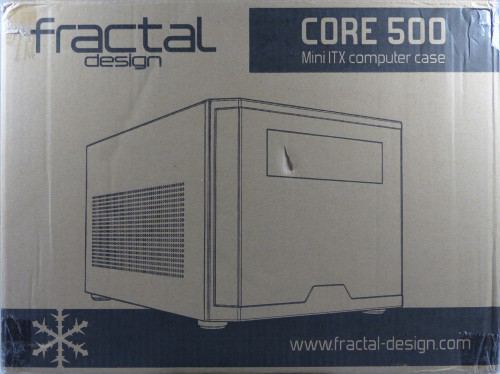

A box in the spirit of Fractal Design, sober and very classic. On one side we have an exploded view of the beast with a listing detailing all the features as well as the make and model. Here marketing is reduced to the maximum, and that’s good!
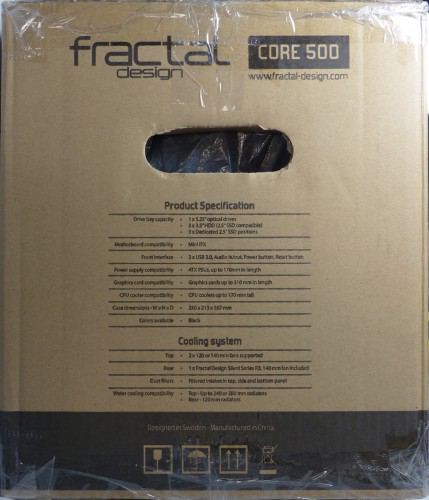
Two handles are present in order to facilitate transport, a listing of technical specifications is present (dimensions, heatsink compatibility, power supply and graphics card as well as a detail of the fans supplied, everything is there!).
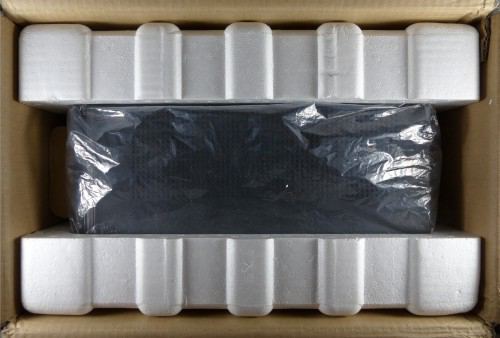
When opening the box we find the Core 500 packed in its plastic bag and between 2 polystyrene molds, we do not say no to protections and with that it should arrive in one piece!
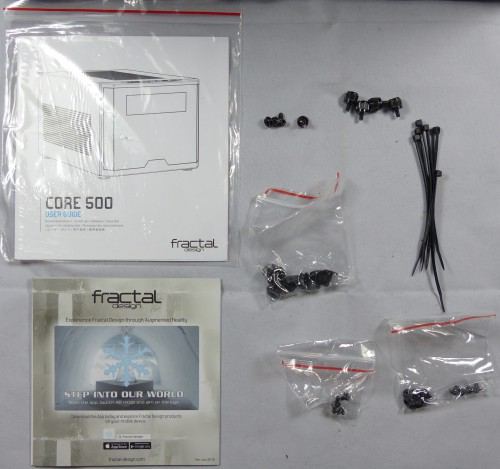
The bundle is rather classic, a manual as well as some plastic cable ties and the necessary screws, Fractal Design has not been eccentric here!

Here is the beast! The design perfectly follows what we are used to seeing in the manufacturer’s “Core” series, such as the core 2500 tested here, sobriety above all! The Core 500 is as we can see all dressed in black, has a plastic front with a brushed aluminum finish very well done, large grilles at the top, on the sides as well as on the front allowing good ventilation. Despite its small size, the beast seems solid and should take the years very well.
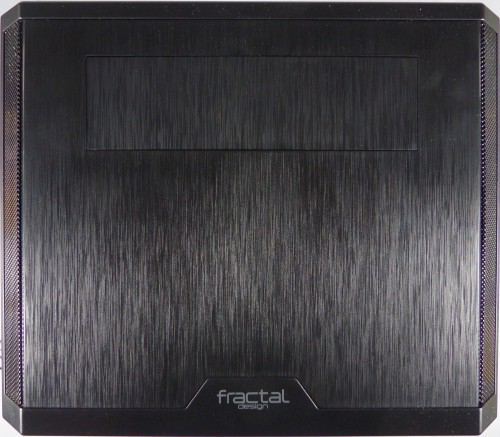
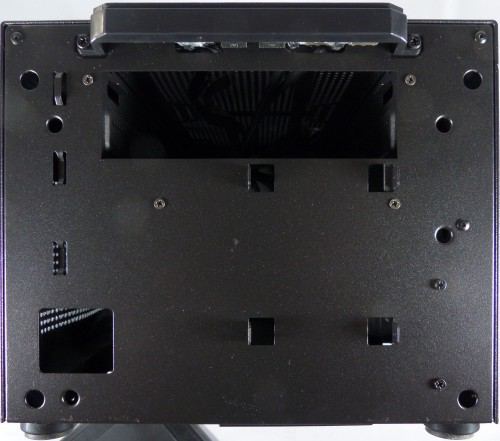
The front panel, all in plastic therefore, is rather successful, the brushed aluminum effect is rather pleasing to the eye and even if everything is in plastic the rigidity is there, the ventilation is done via the grilles on the 2 sides.
Once the front has been removed we find the hole allowing the installation of a 5.25 peripheral as well as a location for a 2.5 ″ peripheral, the hole on the left will be used to pass the cables for the latter, at least the space is good optimized here.
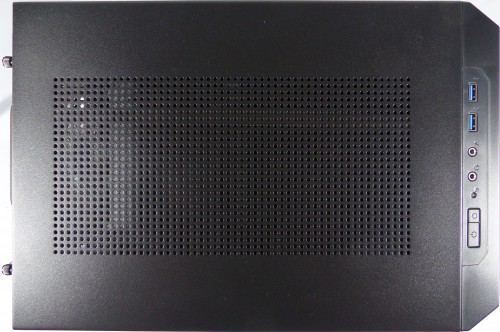
On the top there is a large grid allowing the optional fans to breathe, it will be possible to install between 1 and 2 fans of 12 or 14 cm (but also a water-cooling radiator), enough to ventilate the beast! Towards the front of course we find the connection:

Everything is there, the power and reset buttons, 1 LED for disk activity, the 3.5mm jack connectors as well as the 2 USB 3.0 connectors.
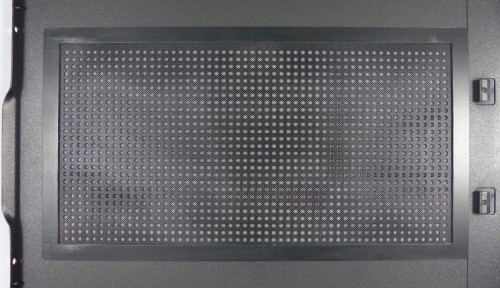
Under the grille below is a removable and magnetic dust filter, this will greatly reduce the frequency of cleaning the interior of the beast, the only concern being that to remove and clean it you have to remove the cover.
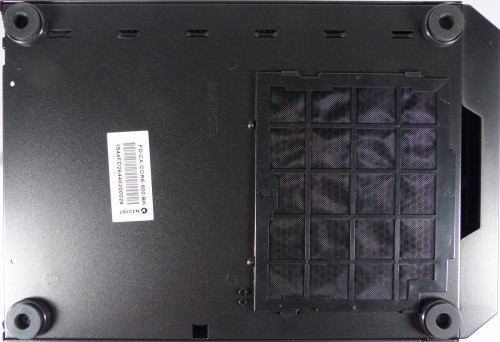
Below are the 4 feet equipped with rubber to avoid transmitting vibrations to the surface on which the Core 500 is placed as well as a removable filter placed in front of the power supply.
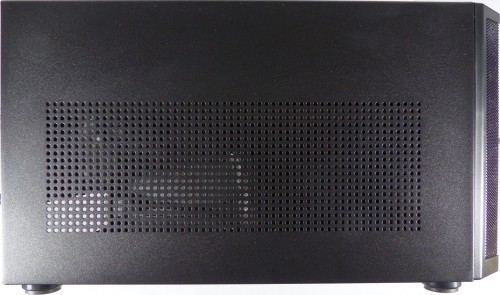
The side given on the graphics card is also equipped with a large grille which will not be too much to let in the fresh air.
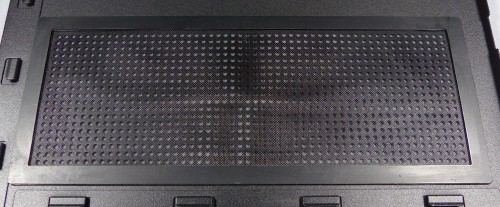
As on the top a removable and magnetic dust filter is also present inside, Fractal Design does everything to prevent dust from rushing into the tower, which is clearly not worse.
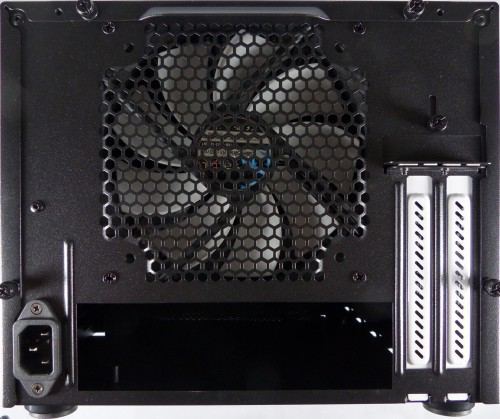
At the rear of the classic, a honeycomb grid behind the fan, the 2 expansion slots are fitted with white brackets, a connector for the mains socket is offset from the power supply which is at the front of the case.
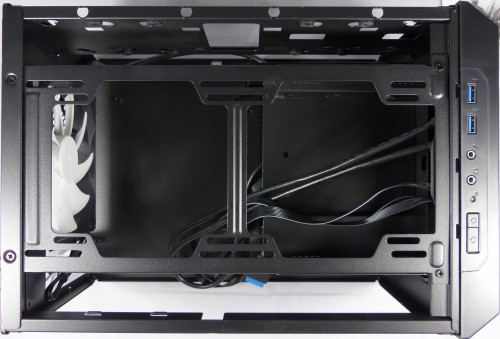
On the top we can see the locations for the fans / watercooling radiators, we can install there as I said 2 fans of 12 or 14 cm, on the right (towards the front of the box) there is a cage allowing the ‘installing the 5.25 ″ device and a 3.5 ″ device. Note that the part of the fans as well as the cage are removable, it is possible for example to remove the cage when installing a 240 or 280 mm radiator.
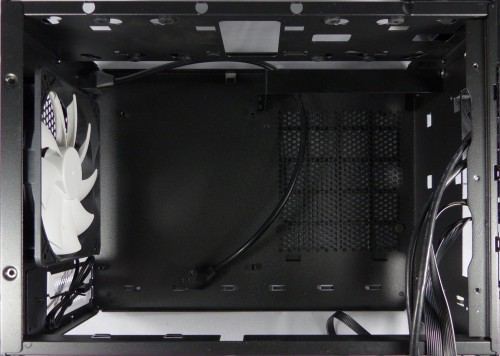
Once everything is removed we can see that everything is breathing, there is almost all of the space available for the various components.
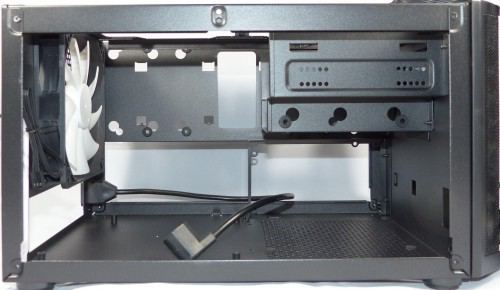
On the side you can see the 5.25 ″ / 3.5 ″ cage a little better, the hard drive that will be installed benefits from rubber silent blocks to reduce vibrations. The CPU cooler on the other hand has free rein, a big monster will not scare the Core 500, on the other hand depending on the model chosen it may be necessary to remove the cage.
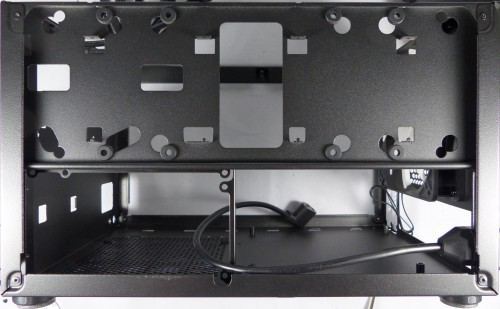
On the other side there is the plate which accommodates the 3.5 ″ and 2.5 ″ peripherals, the 2.5 ″ will be installed on the outside (against the wall surrounding the case) and the 3.5 ″ on the inside.
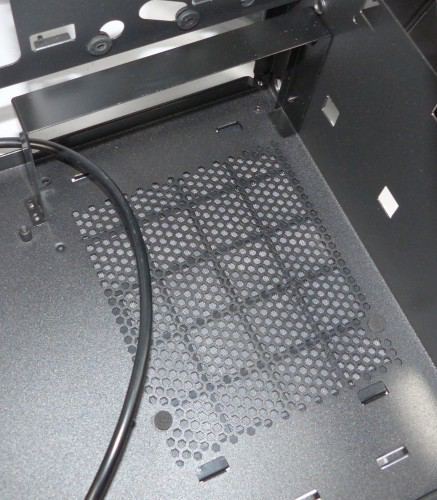
A reinforcement is present in order to fix the power supply to the frame, 2 small rubber pads are also present in order to attenuate any vibration of the latter. The extension cord is long enough to accommodate all power supplies.
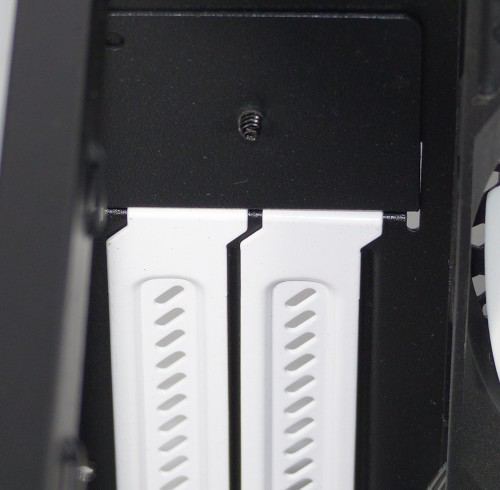
The 2 brackets are white and perforated to allow air to pass through.
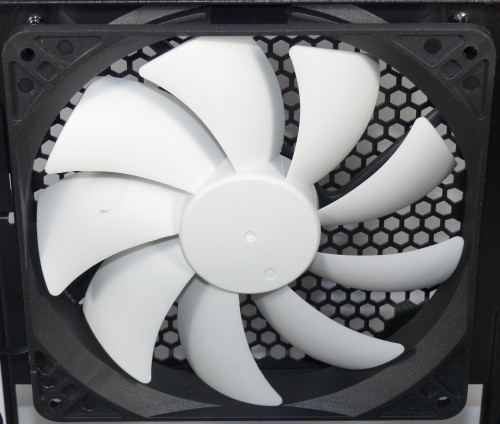
The rear fan is a Fractal Design R3 14cm rotating at a maximum speed of 1000RPM and given for a sound level of 21.6dB maximum. Its weight is 160g and has a 3-pin connector, the cable is black but not sheathed.
The configuration used during the tests is as follows:
- Processeur: Intel Core i5 655K @ Stock
- CPU Fan : Silverstone AR06
- Motherboard : Gigabyte GA-H55N-USB3
- Carte graphique : XFX 7870 Black Edition
- Mémoire: Corsair Veageance 1 x 4 Go 1600Mhz
- SSD: Intel X25-M 80Go
- Disque dur: WD Raptor 150 Go
- Alimentation: Corsair CS-450M
- Operating system : Windows 8.1 64bits
The Fractal Design Core 500 will be tested once with only the SSD plugged in and another test will take place with the Raptor hard drive plugged in, this one being literally hell in terms of its vibrations that will allow you to see how the box reacted. . The case will be tested against its big brother the Fractal Design Node 304 as well as the Silverstone Sugo 13.
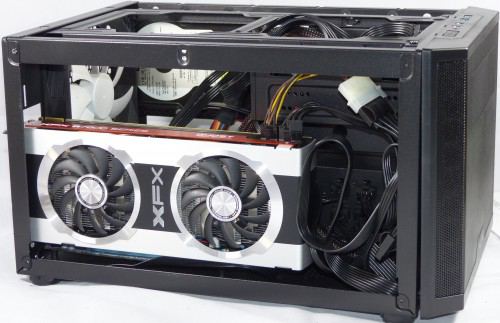
The assembly is done in the same way as in the Node 304, everything is identical except for the installation of the disks, the SSD in the front is installed very easily and is hidden by the front, the raptor takes place on the side and everything else is no problem. Note that the Corsair CS power supply of the test configuration is only 14 cm, with 2 cm more it would not have been possible to install the XFX since the modular cables would have touched, it will be necessary to pay attention to the choice of power supply under penalty of being blocked, a non-modular will be the most suitable if a large graphics card is installed (or then a modular of the Seasonic G type, which will have the modular connectors that will pass underneath).
In order to test the box, I will carry out an OCCT Power Supply test for 30mins and then take the temperatures of the main components such as the processor (average of the 4 cores), the motherboard, the graphics card as well as the hard drive.
Regarding noise pollution, I will proceed as in the file on silent PCs, namely 1 raised in front, to the right, to the left, to the rear and above with the box in a vertical position.
Repos
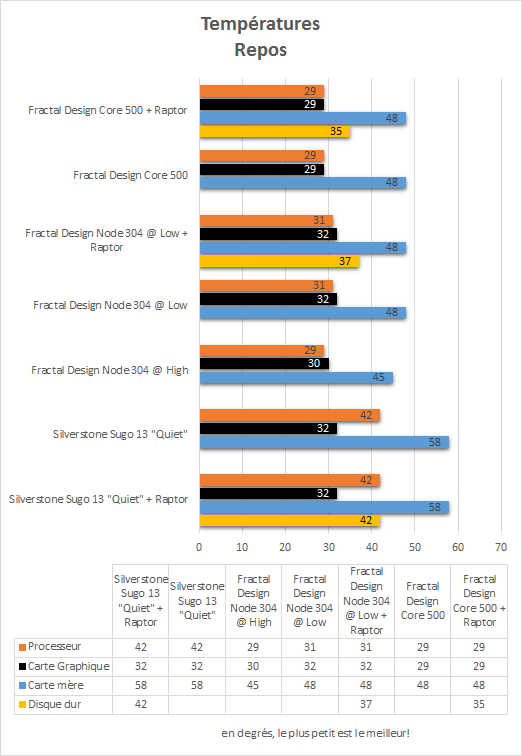
As we can see at the level of temperatures the Fractal Core 500 defends itself very well, at the level of its big brother the Node 304 with 29 ° for the processor and 29 ° for the graphics card, the components are clearly not to be pitied. Given the identical internal layout to Node 304 the similarities in temperatures are not ready to stop, let’s see what it is about noise pollution.
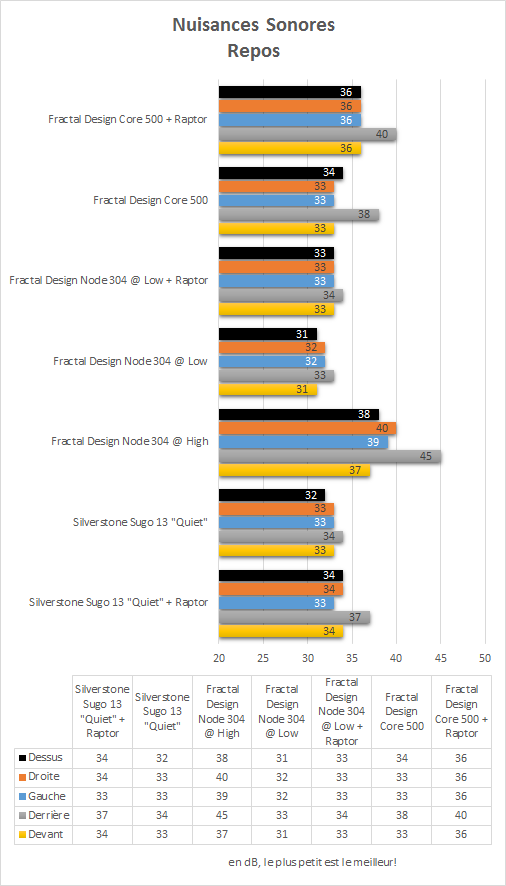
Ambient sound level: 31dB
Here, on the other hand, we can see that everything is not the same as the Node 304, indeed on the Core 500 there is a large opening on the top, a single fan at the back (while there is 1 at the back and 2 at the front on the Node 304). Without the Raptor hard drive installed, noise pollution is really very contained, especially knowing that the fan runs at maximum (no integrated rheobus) with a maximum of 38 dB at the rear for 33/34 dB everywhere else, an excellent result!
On the other hand, once the nightmare in terms of vibrations that is the Western Digital Raptor installed, we can clearly see that the sound level is rising, with between 2 and 3 dB on all measurements. You will therefore have to be very careful when choosing the hard drive if you are sensitive to the noise emitted by vibrations, otherwise you will regret it later.
Regarding the installed fan I have absolutely no complaints, no engine noise, no parasitic noise, only the air flow is heard.
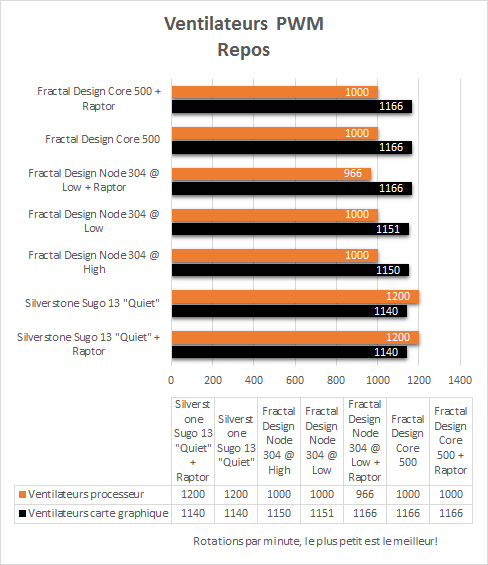
The fans of the CPU cooler as well as of the graphics card rotate here at minimum at rest, the air flow is therefore largely sufficient.
Charge
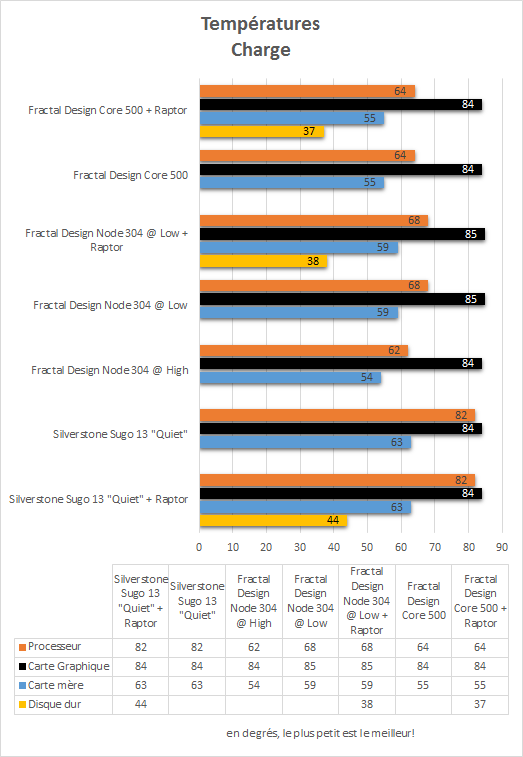
In load, the Core 500 manages to contain the assaults of the various components very well, with 84 ° for the graphics card, 64 ° for the processor as well as 55 ° for the motherboard, we are here almost on a par with the Node 304 (when fans are not at a minimum). It goes without saying that the presence of the fan at the back as well as the various openings greatly help the good cooling of the beast.
When it comes to hard drive cooling the Raptor takes full advantage of the fan that sits right next to it, a good point when you consider how hot it can get if there isn’t enough ventilation.

Ambient sound level: 31dB
As we can see here the noise pollution is higher than with Node 304, indeed there is unfortunately no miracle, the many and large openings on the walls necessarily pass the noise to reach 52 dB at left (where the graphics card is), 50 dB above (above the processor) as well as 48 dB on the right and behind for 45 dB in front. It is clear that the configuration in the box is not silent but it is the case for all the boxes of the comparison, even if the Core 500 is the noisiest in the end.
Note that the choice of components is crucial in all cases, but in particular in a mini-ITX, it will of course be possible to lower the sound level by using a more imposing cooler (such as a Noctua NH-U12S for example), a quieter graphics card and the results will be quite different.
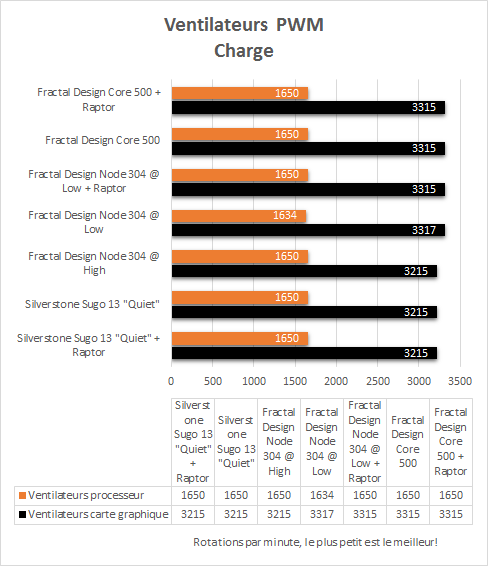
The fans run at the same speed as in its big brother the Node 304, namely 1650 RPM for the CPU cooler and 3315 RPM for the 2 fans of the graphics card (which is the main source of noise pollution generated).

Here we are at the end of this test, what about the Fractal Design Core 500?
After an excellent Node 304 Fractal Design takes the same internal base by changing a lot of things, possibility of installing more fans (2 of 14 cm above in addition to 14 cm at the back), more ventilation as well As removable dust filters and slots for hard drives deported on one side, build quality and sobriety are present as usual. Despite its size, it will be possible to install a cooler up to 17 cm high (or an AIO water-cooling kit from 120 to 280 mm) as well as a graphics card 31 cm in length, as much as the choice is vast and the beast will adapt to any type of configuration.
The performance is good and the components will not suffocate thanks to the many openings present everywhere, which on the other hand will allow noise pollution to escape (especially under load), we have nothing for nothing!
The only little things that I could blame the Core 500 for are the obligation to completely open the beast to clean the dust filters and especially the transmission of vibrations from the hard disks to the case, it will be necessary to pay attention to the models chosen!
Offered at a price of around 70 € it is negotiated at around 15 € less than its big brother Node 304, it is suddenly a bit expensive when you see what the brother offers, but remains however very interesting for those who want install a 5.25 ″ device and / or an AIO water-cooling kit.
Advantages
- Finishing the set
- Build quality
- Sobriety
- Internal space
- Good performance
- Dust filters.
Disadvantages
- .. but you have to remove the panels to clean them
- Disc vibrations
- Open design therefore very sensitive sound level to
the installed components
A big thank you to Fractal Design who allowed me to do this test.















